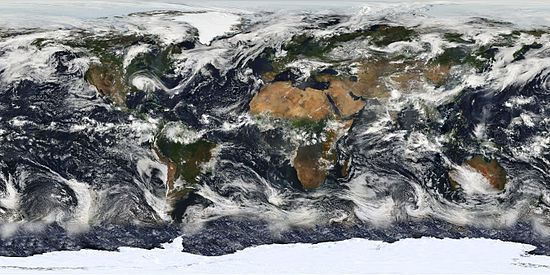Portal:Climate change/Selected picture
(Redirected from Portal:Climate change/picture)
Selected picture 1
Portal:Climate change/Selected picture/1

Credit: User: Splette
The Ocean Circulation Conveyor Belt. The ocean plays a major role in the distribution of the planet's heat through deep sea circulation. This simplified illustration shows this "conveyor belt" circulation.
Selected picture 2
Portal:Climate change/Selected picture/2

Credit: Jami Dwyer
Jungle burned for agriculture in southern Mexico
Selected picture 3
Portal:Climate change/Selected picture/3

Credit: NASA
Orbital photograph of human deforestation in progress in the Tierras Bajas project in eastern Bolivia
Selected picture 4
Portal:Climate change/Selected picture/4

Credit: NASA
Image showing the temperature trend in Antarctica between 1957 and 2006
Selected picture 5
Portal:Climate change/Selected picture/5
This image shows the Arctic as observed by the Advanced Microwave Scanning Radiometer for EOS (AMSR-E) aboard NASA’s Aqua satellite on September 16, 2007. The image denotes a record sea ice minimum in the Arctic.
Selected picture 6
Portal:Climate change/Selected picture/6

Credit: GRID-Arendal
Graph summarizing some of the expected impacts of Global Warming according to the Intergovernmental Panel on Climate Change. Temperature deviations are from 1990 readings.
Selected picture 7
Portal:Climate change/Selected picture/7
The collapse of Larsen B Ice Shelf, showing the diminishing extent of the shelf from 1998 to 2002
Selected picture 8
Portal:Climate change/Selected picture/8
An image of the collapsing Larsen B Ice Shelf and a comparison of this to the U.S. state of Rhode Island.
Selected picture 9
Portal:Climate change/Selected picture/9
Global vegetation – Food, fuel and shelter. Vegetation is one of the most important requirements for human populations around the world. Satellites monitor how "green" different parts of the planet are and how that greenness changes over time. These observations help scientists understand the influence of natural cycles, such as drought and pest outbreaks, on vegetation, as well as human influences, such as land-clearing and global warming.
Selected picture 10
Portal:Climate change/Selected picture/10
The basic function of a space sunshade to mitigate global warming. A 1000 kilometre diameter lens is sufficient, and much smaller than what is shown in this simplified image. As a Fresnel lens it would be only a few millimeters thick.
Selected picture 11
Portal:Climate change/Selected picture/11
Measuring snowpack in a crevasse on the Easton Glacier, North Cascades, USA. The two-dimensional nature of the annual layers is apparent. Crucial to the survival of a glacier is its mass balance, the difference between accumulation and ablation (melting and sublimation). Climate change may cause variations in both temperature and snowfall, causing changes in mass balance.
Selected picture 12
Portal:Climate change/Selected picture/12
Image: Marit Jentoft-Nilsen, NASA
An image of the Earth's cloud cover, which is the amount of sky obscured by clouds, based largely on observations from NASA's Moderate Resolution Imaging Spectroradiometer (MODIS) on board the Terra satellite. Clouds play multiple critical roles in the climate system. In particular, being bright objects in the visible part of sunlight, they efficiently reflect light to space and thus contribute to the cooling of the planet.
Selected picture 13
Portal:Climate change/Selected picture/13
[[File:|center|500px|]]
Selected picture 14
Portal:Climate change/Selected picture/14
[[File:|center|500px|]]
Selected picture 15
Portal:Climate change/Selected picture/15
[[File:|center|500px|]]






